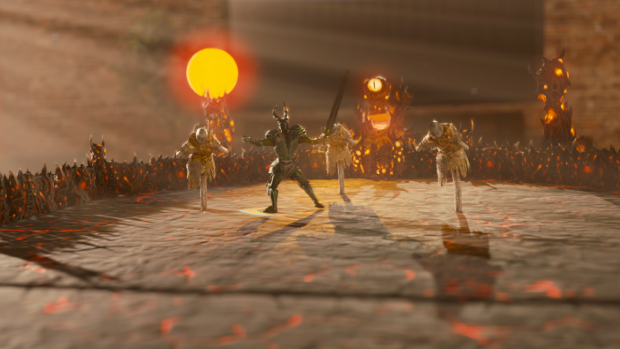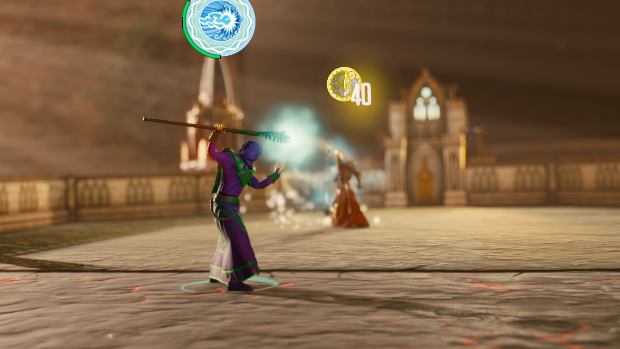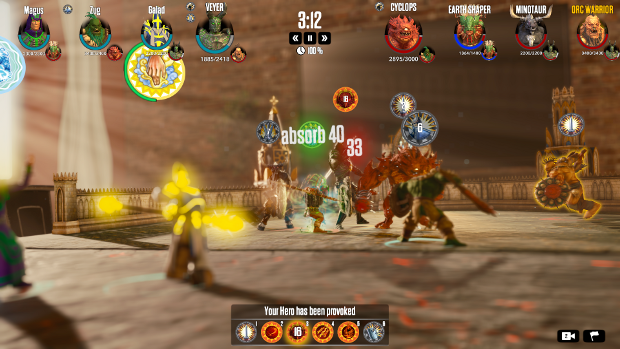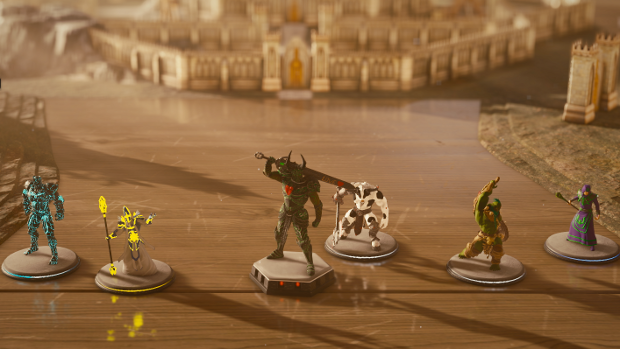Might & Magic Showdown is a great painting tool but a dull game
A great paintjob on an old clunker
Might & Magic Showdown [official site] has popped into existence at a serendipitous time, while I’ve started to crave the delights of painting striking plastic and metal miniatures before sending them into battle. Seeing as how the past has made it clear I don’t really have the patience for it – nor the time, now – the prospect of having a digital suite to make the process considerably quicker and simpler is a seductive one. Lamentably, this fantastic tool is also shackled to a dreadfully dull game that utterly fails to evoke the strategic tabletop romps that inspire it.
Almost everything great about Might & Magic Showdown, at least at this Early Access juncture, is contained within its paint workshop. Once you’ve purchased a mini – using in-game cash earned by winning campaign or PvP battles – you get to name it and give it an intimidating pose, but more importantly you can transform it with a selection of paints that grows as you level up.
Initially, minis come with a plain default skin, grey and metallic, and a ‘classic’ skin that serves as an example of what you can achieve with a little bit of time and a big palette. Within the paint workshop, you can coat entire areas in a click or throw caution to the wind and use the customisable free paint brush. The latter can be a bit fiddly with a mouse, but it’s a necessity if you want to create more intricate designs or make, for example, a mini’s helmet a different colour from the rest of its armour.
Here’s what your first hero, a rather grim demonic knight, looks like with his ‘classic’ skin.
And here’s his alter-ego, Date Knight, courtesy of yours truly.
The editor allows for a surprising amount of expressiveness, and rather effectively mimics the actual process of painting minis, but with the sort of tools you’d expect in a 3D modelling suite. You choose your base colours, applying them individually to armour, flesh and so on, or the entire mini, and add washes and dry brush layers to make shadows and highlights pop. More fine tuning can also be done by using the mask depth slider and by adding extra layers, changing the depth or intensity of the colours respectively.
I really can’t overstate how elegant it is. In a few small steps you can make something entirely new, using only a small number of very flexible tools. It’s the sort of editor you can pick up in seconds. With incredible ease you can touch up a rather boring grey chestplate and transform it into a menacing piece of armour that glows with infernal energy, and by just adding a simple white highlight to a blue base, you can cover a mini in ice.
Excellent, then, but not perfect. The grouping together of different parts of a mini so that they can be painted all at once is convenient, but the ability to create custom groups or just select individual parts would make the feature even more handy. A selection of patterns would be a treat, too, especially if, like me, you’d quite like to deck some heroes out in tartan. And while by no means a deal-breaker, it’s a shame that minis can’t currently be customised beyond their colours. Some different armour or accessories would go a long way to making everyone’s mini collections a little more unique.
When you first pop into the paint workshop, you’ll notice that the starting palette is a bit lacklustre, and to get more minis you also need to buy them, so you’ve got to pack up your little warriors and head to the battlefield diorama for some PvP bouts or campaign missions. And that’s where Might & Magic Showdown stops being fun. I feel like a battle-weary commander, sick of war and bloodshed, just wishing he could go back to his garage and crack open that magical box of paints.
So! 600 words in and I’m just getting to the fisticuffs. I confess that I’ve been putting it off. Battles are real-time scraps between two bands of monsters and warriors. While you can field a bunch of minis, you only get direct control over your hero. With only a single hero to worry about, every battle ends up being a tiresome, albeit brief, slog spent staring at cooldown timers. You click on the enemy you want to attack, your hero will automatically run towards them, and then you just click on abilities until they are dead. At least while you wait for those abilities to activate you can keep clicking the basic attack, giving your finger a very gentle workout. No, there’s no auto attack.
Creatures, the minis you have no direct control over, have customisable scripts that determine how they act in a fight. These scripts are Showdown’s single interesting wrinkle and its only tactical system. By making a custom script, you’re creating a chain of possibilities and reactions, selecting the type of combo a creature uses against specific enemies. You can make one of your mages focus on taking out enemy supports and finishing off stragglers, while your fiery warrior taunts groups of enemies before unleashing an AoE beatdown.
It can be tempting to create all these elaborate scripts dealing with ultra-specific scenarios, using all sorts of long combos, but that can lead to an unfocused creature who, while locked into these five-move combos, can’t react quickly to an evolving battle. However, attacks placed further down a combo chain do more damage, so risk-takers can be rewarded. Unfortunately, it’s hard to tell how effective a script actually is.
Battles are largely impossible to follow, with an unhelpful camera and magical effects ensuring that the action is almost always obscured. And since these messy brawls are all in real-time, and you’ve got to keep watching your hero’s cooldowns, it’s hard to find a moment to check in on your creatures. Victory isn’t a particularly good indicator of whether or not your scripts were genuinely helpful, either. Maybe you just faced a less experience or skilled opponent. Perhaps it was your hero’s abilities or your creature selection that saved the day.
What’s really strange is that none of this evokes the sort of tabletop strategy and roleplaying games that clearly inspire Showdown. There’s little of the meaningful progression you get in the latter, aside from a linear series of abilities that unlock as heroes and creatures level up; nor are there any of tactical considerations or strategic conundrums that you’d expect to find in the former. The most notable departure is the choice of real-time combat, which doesn’t remotely work or leave much room for tactics, especially when you’re relegated to simply selecting enemies and hitting hotkeys. It’s the game’s largest obstacle, but is, according to the developers, part of their vision, so there’s no hope of a switch to a turn-based system. Not that such a switch is the only solution – they could also make a real-time system that wasn’t dreadful.
Might & Magic Showdown is a bit of a cypher. It’s attached to a franchise that is has nothing to do with and is inspired by games with mechanics that it entirely rejects. It’s not clear what Ubisoft are really going for here, and right now if feels like a mess of ideas that aren’t really sticking. Yet still I play. I haven’t enjoyed a single battle, but I’m having the time of my life painting my minis.
Might & Magic Showdown is in Early Access, and is available now for Windows, at £15.99.
















